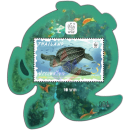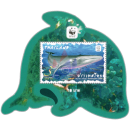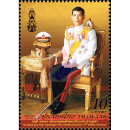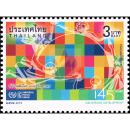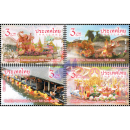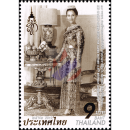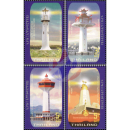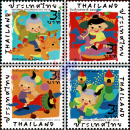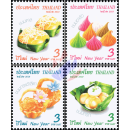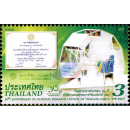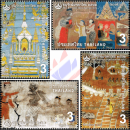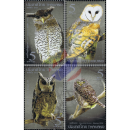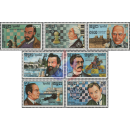Description
Opr. (2x5); A = perf. K 13 1/4; B = imperforated
Set, Date of issue: 11.09.2019
Picture descriptions:
fbs-fbv) Protected marine animals, WWF Emblem
fbs) Bryde's Whale (Balaenoptera edeni)
fbt) Omura´s Whale (Balaenoptera omuri)
fbu) Whale shark (Rhincodon typus)
fbv) Leatherback turtle (Dermochelys coriacea)
3784A 3 B multicolored fbs
3785A 3 B multicolored fbt
3786A 3 B multicolored fbu
3787A 3 B multicolored fbs
Quantity: 500,000 pieces
Designer: Mr. Udorn Niyomthum (Thailand Post)
Printer: Thai British Security Printing, Thailand
Conservation Status:
Here as a "MINT NEVER HINGED (MNH)" perforated set
Issue Notice:
- Souvenir Sheet 375A and Souvenir Sheet 376A have the outlines of a whale and a sea turtle
- Souvenir Sheet 374A was only sold to VIP customers together with the sheetlet set, KB(I).
-
Bryde´s Whale:
- The Bryde´s whale (Balaenoptera edeni) is a Walart from the family of the furrow whales (Balaenopteridae). The species was named after the Norwegian whaler and ship owner Johan Bryde (1858-1925). The status of the Eden whale, which is also often regarded as a species of its own, is unclear; it was described as a separate species on the basis of genetic studies in 1993, but according to its current state it is not considered independently.
- With a length of 12 to 14 meters and a weight of 16 to 25 tons of Bryde's Whale is one of the smaller furrows. He has an elongated, dark gray body, which is slightly lighter colored only at the throat and belly. Characteristic of this species are three strip-like beads on top of the head. The sei whale, which looks quite similar to the Bryde's whale, has only one spar in the middle of the head. The crescent-shaped fin sits as in all furrows whales far behind the body, the Fluke is clearly notched.
-
Omura´s Whale:
- The Omura´s whale (Balaenoptera omurai) is a type of furrow whale (Balaenopteridae) first described in November 2003. The type specimens of the species were caught in the late 1970s in the Sea of Japan (Terra typica), in the Salomonensee and near the Cocos Islands. According to the first describer Shiro Wada, Masayuki Oishi and Tadasu K. Yamada from Japan is a very similar to the fin whale (Balaenoptera physalus), but with a length of about twelve meters, much smaller than this.
- They also have less than other baleen whales with only 200 species. About the way of life of the animals is not known.
-
Whale Shark:
- The Whale shark (Rhincodon typus) is the largest shark and at the same time the largest fish of the present. It is the only species of the genus Rhincodon, which in turn is the only genus within the family Rhincodontidae. The whale shark belongs to the order of the nurse shark-like. The longest specimen of a whale shark measured so far reached 13.7 m. Whale sharks can reach a weight of over 12 tons. They feed on plankton and other microorganisms like giant sharks and giant mealy sharks, which they filter by sucking in the water. According to recent studies, they also eat fish up to the size of mackerel and small tuna, so up to about one meter.
- Because of its food specialization, this shark is safe for humans, for example, in the north of Western Australia snorkeling trips are offered with whale sharks.
-
Letherback Turtle:
- The leatherback turtle (Dermochelys coriacea) is the largest living turtle and is usually regarded as the only member of the same family (Dermochelyidae). Thus it does not count zoologisch to the family of the sea turtles (Cheloniidae), but is united together with these in the superfamily Chelonioidea. Their habitat is tropical and subtropical seas. So far, no subtypes are distinguished for this species. The animals reach a tank length of up to 2.5 meters and a weight of almost 700 kilograms.
- Similar to the soft-shelled turtles and unlike other turtles, the leatherback turtle does not have a typical dorsal shield with horny scales. The loosely connected bone armor is rather surrounded by a rough leather-like skin. The tank is elongated and runs to the rear pointed. On the blue-black back are clearly seven thickened bone plates or longitudinal keels to see.

